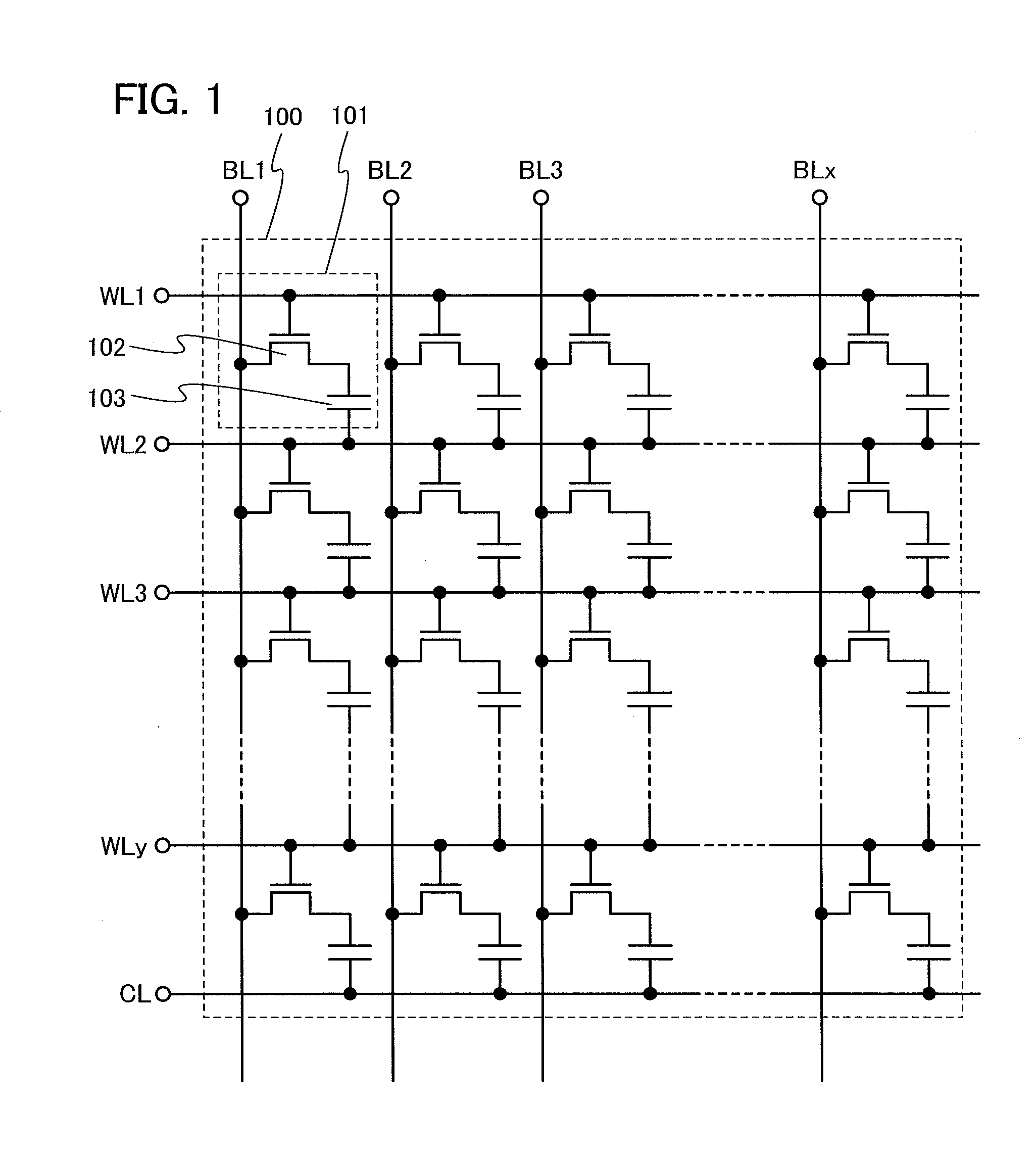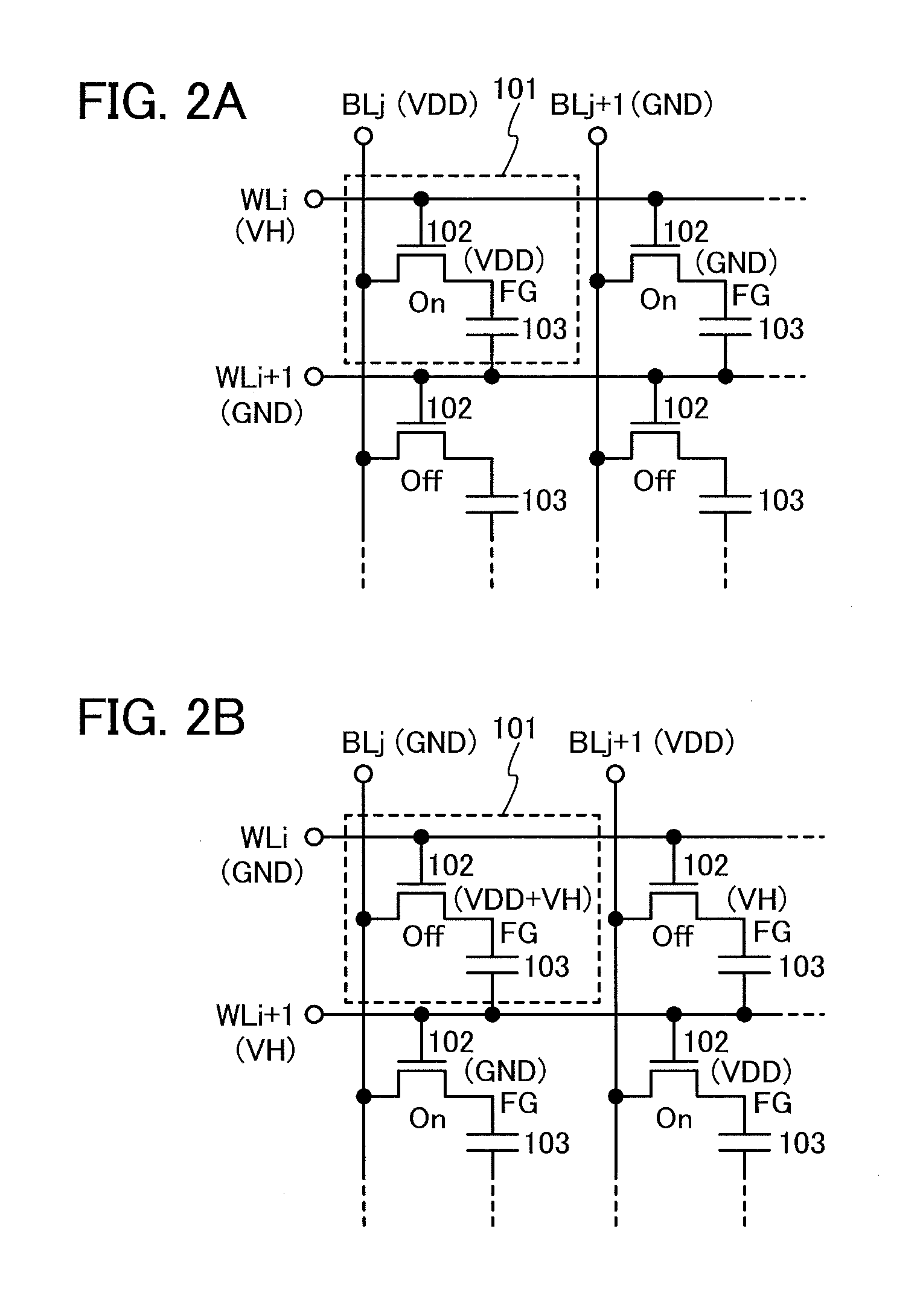Semiconductor device
a semiconductor and memory device technology, applied in semiconductor devices, digital storage, instruments, etc., can solve the problems of increasing the number of manufacturing steps, complicated manufacturing process, and difficult for transistors of different conductivity types to have uniform transistor characteristics, so as to reduce the number of lines included in a cell array, the effect of preventing the leakage of charge from the capacitor
- Summary
- Abstract
- Description
- Claims
- Application Information
AI Technical Summary
Benefits of technology
Problems solved by technology
Method used
Image
Examples
embodiment 1
[0050]FIG. 1 shows an example of a circuit diagram of a structure of a cell array 100 in the memory device according to one embodiment of the present invention. The cell array 100 shown in FIG. 1 includes a plurality of memory cells 101 arranged in matrix, a plurality of word lines WL, and a plurality of bit lines BL. A signal from a driver circuit is supplied to each memory cell 101 through the plurality of word lines WL and the plurality of bit lines BL.
[0051]The number of the word lines WL and the number of the bit lines BL can be determined in accordance with the number of the memory cells 101 and arrangement of the memory cells 101. The cell array 100 shown in FIG. 1 includes memory cells 101 in x rows and y column (x and y are both natural numbers), word lines WL1 to WLy, and bit lines BL1 to BLx.
[0052]Each memory cell 101 includes a transistor 102 serving as a switching element and a capacitor 103. Note that the memory cell 101 may further include another circuit element such...
embodiment 2
[0162]In this embodiment, a structure of a cell array 200 which is different from that of FIG. 1 in the memory device according to one embodiment of the present invention will be described.
[0163]FIG. 9 is an example of a circuit diagram showing a structure of the cell array 200 of this embodiment. In the cell array 200 shown in FIG. 9, a plurality of memory cells 201 is divided into two blocks: a first block 290 and a second block 291. The memory cell 201 included in the second block 291 is provided over a memory cell 201 included in the first block 290. That is, the cell array 200 in this embodiment has a structure in which the memory cells 201 are stacked.
[0164]Note that FIG. 9 shows an example in which the plurality of memory cells 201 is divided into two blocks: the first block 290 and the second block 291; however, the present invention is not limited to this structure. The memory device according to one embodiment of the present invention may have a structure in which three or...
embodiment 3
[0198]In this embodiment, a manufacturing method of a transistor forming a cell array will be described. Note that in this embodiment, a transistor formed using an oxide semiconductor will be described as an example.
[0199]First, as illustrated in FIG. 12A, an insulating film 701 is formed over a substrate 700, and conductive films 702 and conductive films 703 are formed over the insulating film 701. The conductive film 702 serves as a gate electrode of each of a transistor 712 and a transistor 713, and further serves as a word line. The conductive film 703 serves as another word line.
[0200]Although there is no particular limitation on a material which can be used as the substrate 700, it is necessary that the material have at least heat resistance high enough to withstand heat treatment to be performed later. For example, a glass substrate manufactured by a fusion process or a float process, a quartz substrate, a semiconductor substrate, a ceramic substrate, or the like can be used ...
PUM
 Login to View More
Login to View More Abstract
Description
Claims
Application Information
 Login to View More
Login to View More - R&D
- Intellectual Property
- Life Sciences
- Materials
- Tech Scout
- Unparalleled Data Quality
- Higher Quality Content
- 60% Fewer Hallucinations
Browse by: Latest US Patents, China's latest patents, Technical Efficacy Thesaurus, Application Domain, Technology Topic, Popular Technical Reports.
© 2025 PatSnap. All rights reserved.Legal|Privacy policy|Modern Slavery Act Transparency Statement|Sitemap|About US| Contact US: help@patsnap.com



